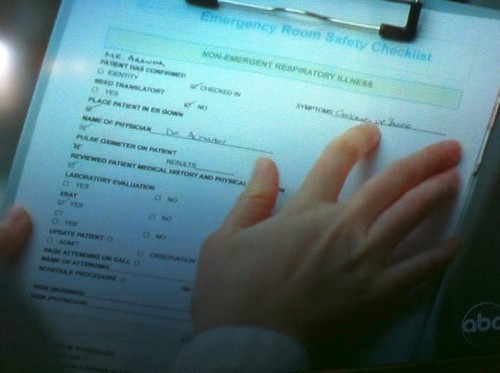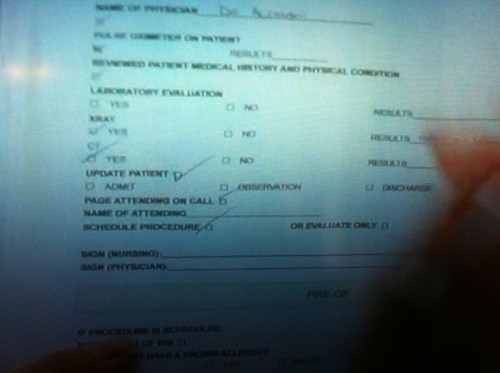 It's my second post about the TV show Grey's Anatomy, the first being “McDreamy” Fights the Blame Game on “Grey's Anatomy.” Each post makes it less believable that I don't watch the show religiously. Thanks go to my wife for detecting something Lean related and calling me into the room to watch.
It's my second post about the TV show Grey's Anatomy, the first being “McDreamy” Fights the Blame Game on “Grey's Anatomy.” Each post makes it less believable that I don't watch the show religiously. Thanks go to my wife for detecting something Lean related and calling me into the room to watch.
Last week's episode had a subplot about Checklists and protocols. A number of blog readers also emailed or tweeted saying I needed to check it out. I've compiled about 3:30 of the Checklist-related clips into a video for this post – I hope it's educational and provides a way to talk in your hospital about the real-world issues related to Checklists.
In the video, you see a sequence of events from throughout the episode (yes, the love stories and other drama have been edited out):
- An eager resident, April, is telling the head of trauma surgery about checklists and how they're taken from aviation safety
- The checklist she is talking through is for the emergency department (we normally hear about checklists in operating rooms)
- Another resident, Cristina, purposefully violates “proper protocol” and refuses to page the attending (it is a very unusual case involving a small tree in a patient's lungs and Christina wants to do the procedure herself).
- April calls out Cristina for violating protocol, Cristina argues she “streamlined it.”
- During surgery, Cristina says she wants to keep the small tree. April argues that proper protocol is to send it to pathology for disposal. Cristina gives a speech, “Protocol accounts for whatever comes up. That's why we have protocol, so there are rules and steps that we can depend on. I know the rules seem fussy and annoying and the people who enforce them are fussy and annoying too, but they are there for a reason.” Cristina says, “I don't care how many boxes you check, you're not going to be chief resident.”
- In a final scene, April gives a little speech at the bar (as her colleagues roll their eyes), “You know the rules are there for a reason. I killed a woman when I first started here. I got fired for it because I missed a little step. One simple step. If you follow the protocol, you don't skip steps. People live. Simple as that. The checklists work. You can't tell me they don't.”
Here is the edited video:
Let's dig into a few details about the checklists as shown here.
Dr. Atul Gawande, in his outstanding book The Checklist Manifesto: How to Get Things Right, he emphasizes that checklists don't contain every single step, just the most important steps that are likely to be forgotten or skipped.
Is the checklist overly specific? It says, on the third line, “PLACE PATIENT IN ER GOWN.” Is that really a necessary thing for a checklist? Being overly specific like this is one reason some people react to checklists as being silly.
Below, we can see the boxes that Cristina just checked without really properly going through them. Page attending got checked, although she never planned on doing it.
It's often too easy to just check the list without really doing the steps. I've seen hospital departments where there was supposed to be a checklist done daily to verify that all needed emergency supplies were present. Doing spot checks, there was always at least one item missing, although somebody had checked the boxes everybody. In the UK, they'd warn against a “tick box” exercise, if I have the lingo right.
In cases like this, or in other standardized work, who is checking to make sure the checklist is being properly followed? In the Grey's Anatomy full episode, the attending DOES somehow find out that Cristina wasn't following protocol, but the patient said he wanted Cristina to do the procedure (hence the “hostile environment” comment and the stare from the attending from outside the O.R.). I think the implication was that April ratted Cristina out – that's not ideal management of standardized work, especially since April's motivation was probably more about currying favor to try to be chief resident (or maybe she was concerned about what was best for the patient too).
What are your reactions to the clips? How do you feel about the portrayal and the situations as a healthcare professional or as an outsider?
Dr. Gawande emphasizes, as we would with Lean standardized work, that the checklist isn't a substitute for thinking and judgment. But, here, we clearly see a doctor who thinks the protocol is interfering with what she wants to do (also, seemingly, for selfish motives). Are checklists overly fussy and annoying? How do we find the balance between helpful and not being annoying?
What do you think? Please scroll down (or click) to post a comment. Or please share the post with your thoughts on LinkedIn – and follow me or connect with me there.
Did you like this post? Make sure you don't miss a post or podcast — Subscribe to get notified about posts via email daily or weekly.
Check out my latest book, The Mistakes That Make Us: Cultivating a Culture of Learning and Innovation:












From a facebook friend who works in healthcare:
“Mark, great article and thanks for pointing this out. I’m not much of a TV watcher but I believe this is a great example of how media (TV in this case) can help raise awareness to methods that improve healthcare – a great case in point for anyone who does not like checklists. “They work” – until we find something better – we should use them. Thanks again Mark for making each of us realize how every day there are great discussions, new content available everyday, to be used to facilitate these discussions and raise awareness. “
The practice, in aviation, is called “pencil-whipping.” If a pilot did this on a checklist, he or she would be in job-threatening trouble. If a mechanic did it (checking off maintenance he did not do), he could be in legal trouble. A physician friend of mine reviews Social Security disability applications. She has uncovered efficient, EMR-enabled pencil-whipping–they just cut and paste, cut and paste, then get reimbursed for everything they SAY they do. She has discovered a physician who said he did a diabetic foot exam on an amputee, for example. Pencil-whipping is fraud.
Checklists are like kanbans: they are the tools, and absent the underlying philosophy and leadership, they are just tools. Using the tools would be better than not using the tools. But checklists are meant to reinforce the attitudes and behaviors that promote teamwork and safety. Medicine has far to go.
Thanks for posting, Mark.
Very interesting and its great to see mainstream tv highlighting basic day to day running issues. What the clip does best is highlight the people issues surrounding checklists and other standard protocol.
The behaviours played out could easily occur and probably do, in many sectors. On the one side we see an initial patient centered thought process and behaviour clashing with the arrogant I’ll do it my way self importance behaviour. Interesting how true values are then exposed with a bribe.
What I don’t know is whether the particular checklist was delivering customer value in the form of quality and consistency of care or whether it was over bureaucratic and adding waste.
The only clear exposure was that of individuals not respecting each other or showing any humility. Interestingly the two female protagonists were displaying what I class as macho shop floor behaviour.
I think the clip is a fantastic opener to group discussion surrounding checklists and standards, thanks for posting.
@kopstar – I think that representation of a checklist probably wasn’t created with Dr. Atul Gawande as an overseeing medical consultant.
The patient getting into a gown – that’s not exactly a “miss a step and people die” situation.
But the clip opens things up for great discussion around what should be on a checklist and how it should be managed.
Checklists, as used in professional aviation today, serve two functions. The first, as noted above, is to ensure that what we’re supposed to do, we do. Standardized work.
The other function they serve is to invoke dialogue. For instance, when we did the Before Starting Engines checklist in Frankfurt this morning, one of the line items is “Takeoff Briefing”. This item is a prompt for the captain to brief the crew on expectations for the takeoff in normal, abnormal, and emergency conditions. It’s also a prompt for the crew to turn and listen. The captain then says, “What questions do you have?” This is how a Tool that’s over 50 years old in our profession, has been updated to improve communication and teamwork.
Sadly, it’s still the case in healthcare that it is April who stands out because she insists on protocol, and Christina who has the cool, competent demeanor.
In aviation, and other high reliability organizations, Christina would be dismissed as a hack, and drummed out of the organization. Using a checklist isn’t for “people who need it,” it’s the hallmark of a true professional.
Until healthcare cottons to this reality, then they’ll continue to kill, maim, and hurt the innocent. Perhaps that’s the reason for the strong resistance, it’s not the clinician who’s suffering.
Steve – thanks for your insights and experience. It sure doesn’t seem like an environment of mutual respect at the hospital portrayed in Grey’s Anatomy.
Although I used to work on Grey’s Anatomy, I stopped following the show a long time ago.
You used the term “ratted out” with respect to what the resident likely did. That negative term implies that the resident did something unsavory. In my perspective, however, the resident, for whatever motives, actually did the RIGHT thing. Bad things happen when good people stand by and do nothing. Hospital personnel should be on notice that their practices are being watched by colleagues and, when they deliberately bypass regulations and protocols for whatever reason, their colleagues have an obligation to call them out on it or even report it. Now maybe that might contribute to an atmosphere of paranoia but reasonable protocols are put in place, most often to protect patients, as well as others, from harm. Thousands of patients die every year in hospitals from HAIs, many from a failure by staff to do a simple thing like wash their hands between patients. That isn’t just inexcusable – it’s criminal. Patients shouldn’t have to spend extra days in the hospital or be damaged or killed just to maintain a collegial atmosphere. There’s simply too much at stake and true professionals wouldn’t want to work in an organization that has “standards” of convenience.
Stuart – I agree with you that the resident probably did the right thing. I used the term “ratted out” without proper context… from Cristina’s standpoint, she was “ratted out.”
Sadly, both of the characters had their own interests placed far above the patient’s needs.
I agree 100%. The video allows us to have that discussion about getting people to speak up (for the right reasons) if they see a checklist or time-out is being skipped before a procedure or even for something as simple as a person not following proper hand hygiene practices.
I don’t think what is on the checklist is the issue. The issue is that the checklist hasn’t been accepted as a standard practice. The behaviours are wrong not the tool. If the checklist is an agreed standard it should be followed with the caveat being that like any other standard it can be challenged and improved through PDCA.
If the checklist isn’t an accepted standard those who are supposed to be using it require teaching/coaching to understand why it is being introduced as a concept then given an opportunity to design it as a team so that what is important is included and what isn’t can be excluded – it then creates value as it ensures patient care through consistent standards of quality.
The most important thing is the acceptance of the tool through understanding and shared ownership whereas in this case the change has been imposed and as is typical then being “opposed”.
Good point, @kopstar. In the fictional Seattle Grace setting, it could be that the checklist was not created in a very collaborative way. If it was just created by a single person or by the attending and then forced on everyone, that’s one reason the checklist might not be super helpful or why it might not be accepted. Maybe there’s no mechanism for discussing PDCA or kaizen of the checklist. If people honestly think it’s dumb, they need to say so. If it were me, I would maybe challenge why putting the patient in a gown is on the checklist.
When I have my checklist for podcasts, I don’t say “make sure the microphone is connected properly,” because I’ve never had a problem with that.
https://www.leanblog.org/2010/03/how-checklists-help-me-with-my-podcasts/
One could argue that Christina was practicing PDCA/Kaizen on the standard work when she ‘auto’ ticked the checklist ;)
Except we didn’t see Cristina taking any steps to actually get the form changed if some of those steps were unnecessary.
HEALTH CARE MENTAL MODELS?
Terrific piece, Mark — thanks. Thank ya’ll for the fine comments too.
Have to confess I don’t watch Grey’s Anatomy. (Unless it follows the hockey game — yes, I’m a puckhead…)
Anyhow, from the episode & comments I would infer the following core health care mental models.
(Mental models are like glasses we all wear, which filter, and often distort, reality. For more please see references in my post script)
1) Standards are optional.
2) Standards = bureaucracy
3) Health care is “different”. (What applies in other industries does not apply here.)
4) Doctors are imperious & do as they please.
5) We in health care are very smart successful people — (and therefore don’t need checklists and the like)
Are these mental models at all representative of health care?
Are there any others we should talk about?
Love to hear your thoughts.
Best regards,
Pascal
PS For more on mental models, check out Getting the Right Things Done. For more on health care mental models, check out chapter 10 of The Remedy – Bringing Lean Out of the Factory…